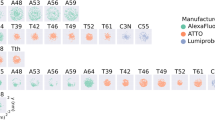Abstract
The end-to-end distance distribution of a flexible molecule was recovered from steady-state fluorescence energy transfer measurements using the method suggested by Cantor and Pechukas (Proc. Natl. Acad. Sci. USA 68, 2099–2101, 1971). In this method, the Förster distance (R 0) is varied by attaching different donor-acceptor (D-A) pairs to the flexible linker of interest. Distance distributions are then recovered from energy transfer efficiency measurements on the set of D-A pairs with differentR 0 values. Thirteen D-A pair compounds were synthesized withR 0 values ranging from 6 to 32 Å. Each compound contained a tryptamine donor linked by an alkyl chain (∼10 carbons) to 1 of 13 acceptors. Using these compounds, we have experimentally confirmed the Cantor and Pechukas method for recovering distance distributions. The measured transfer efficiencies, as a function ofR 0, were fit to the transfer efficiencies predicted for both Gaussian and skewed Gaussian distance distributions. The data support the existence of a skewed Gaussian distribution, and we believe that this is the first experimental observation of an asymmetric distribution for a flexible molecule using fluorescence resonance energy transfer measurements. Finally, the experimentally recovered distance distribution was found to be in good agreement with the distribution predicted from the rotational isomeric state model of Flory (Statistical Mechanics of Chain Molecules, John Wiley & Sons, New York, 1969, Chaps. 1, 3, and 5) but not with the predicted distribution for a freely rotating or freely jointed chain.
Similar content being viewed by others
References
C. R. Cantor and P. Pechukas (1971)Proc. Natl. Acad. Sci. USA 68, 2099–2101.
P. Flory (1969)Statistical Mechanics of Chain Molecules, John Wiley & Sons, New York, Chaps. 1, 3, and 5.
I. Gryczynski, W. Wiczk, M. L. Johnson, and J. R. Lakowicz (1988)Chem. Phys. Lett. 145, 439–446.
I. Gryczynski, W. Wiczk, M. L. Johnson, H. C. Cheung, C. K. Wang, and J. R. Lakowicz (1988)Biophys. J. 54, 577–586.
J. R. Lakowicz, M. L. Johnson, W. Wiczk, A. Bhat, and R. F. Steiner (1987)Chem. Phys. Lett. 138, 587–593.
J. R. Lakowicz, I. Gryczynski, H. C. Cheung, C. K. Wang, and M. L. Johnson (1988)Biopolymers 27, 821–830.
J. R. Lakowicz, I. Gryczynski, H. C. Cheung, C. K. Wang, M. L. Johnson, and N. Joshi (1988)Biochemistry 27, 9149–9159.
S. Albaugh and R. F. Steiner (1989)J. Phys. Chem. 93, 8013–8016.
R. D. Remington and M. A. Schork (1985)Statistics with Analications to the Biological and Health Sciences, Prentice-Hall, Englewood Cliffs, NJ, Chap. 2, p. 14.
E. Haas, C. A. McWherter, and H. A. Scheraga (1988)Biopolymers 27, 1–21.
N. A. Metropolis, A. W. Rosenbluth, M. N. Rosenbluth, A. H. Teller, and E. Teller (1953)J. Chem. Phys. 21, 1087–1092.
S. Prémilat and J. Hermans Jr. (1973)J. Chem. Phys. 59, 2602–2612.
B. Valeur, J. Mugnier, J. Pouget, J. Bourson, and F. Santi (1989)J. Phys. Chem. 93, 6073–6079.
E. Hardin Strickland, J. Horwitz, E. Kay, L. M. Shannon, M. Wilchek, and C. Billups (1971)Biochemistry 10, 2631–2638.
K. Clausen, M. Thorsen, and S.-O. Lawesson (1982)Chem. Scripta 20, 14–18.
K. Clausen, M. Thorsen, and S.-O. Lawesson (1981)Tetrahedron 37, 3635–3639.
D. W. Brown, M. M. Campbell, and C. V. Walker (1983)Tetrahedron 39, 1075–1083.
M. Bodanszky and A. Bodanszky (1984)The Practice of Peptide Synthesis, Springer-Verlag, Berlin, Chap. 1A, p. 26.
R. F. Chen (1967)Anal. Biochem. 1, 35–42.
J. N. Demas and A. W. Adamson (1973)J. Am. Chem. Soc. 95, 5159–5168.
J. R. Lakowicz, J. Kusba, W. Wiczk, and I. Gryczynski (1990)Chem. Phys. Lett. 173, 319–326.
J. R. Lakowiczet al., unpublished observations.
A. Abe, R. C. Jernigan, and P. J. Flory (1966)J. Am. Chem. Soc. 88, 631–639.
A. Abe and J. E. Mark (1976)J. Am. Chem. Soc. 98, 6468–6476.
E. Riande and J. Guzman (1985)J. Polym. Sci. Polym. Phys. Ed. 23, 1235–1245.
W. Mattice, personal communication.
P. R. Bevington (1969)Data Reduction and Error Analysis for the Physical Sciences, McGraw-Hill, New York, pp. 200–201, 318.
66th Handbook of Chemistry and Physics (1985) CRC Press, Boca Raton, FL, pp. F-165–F-166.
R. W. G. Wyckoff (1966)Crystal Structures, John Wiley & Sons, New York, pp. 53, 82, 288, 682.
Author information
Authors and Affiliations
Rights and permissions
About this article
Cite this article
Wiczk, W., Eis, P.S., Fishman, M.N. et al. Distance distributions recovered from steady-state fluorescence measurements on thirteen donor-acceptor pairs with different Förster distances. J Fluoresc 1, 273–286 (1991). https://doi.org/10.1007/BF00865251
Received:
Revised:
Accepted:
Issue Date:
DOI: https://doi.org/10.1007/BF00865251



